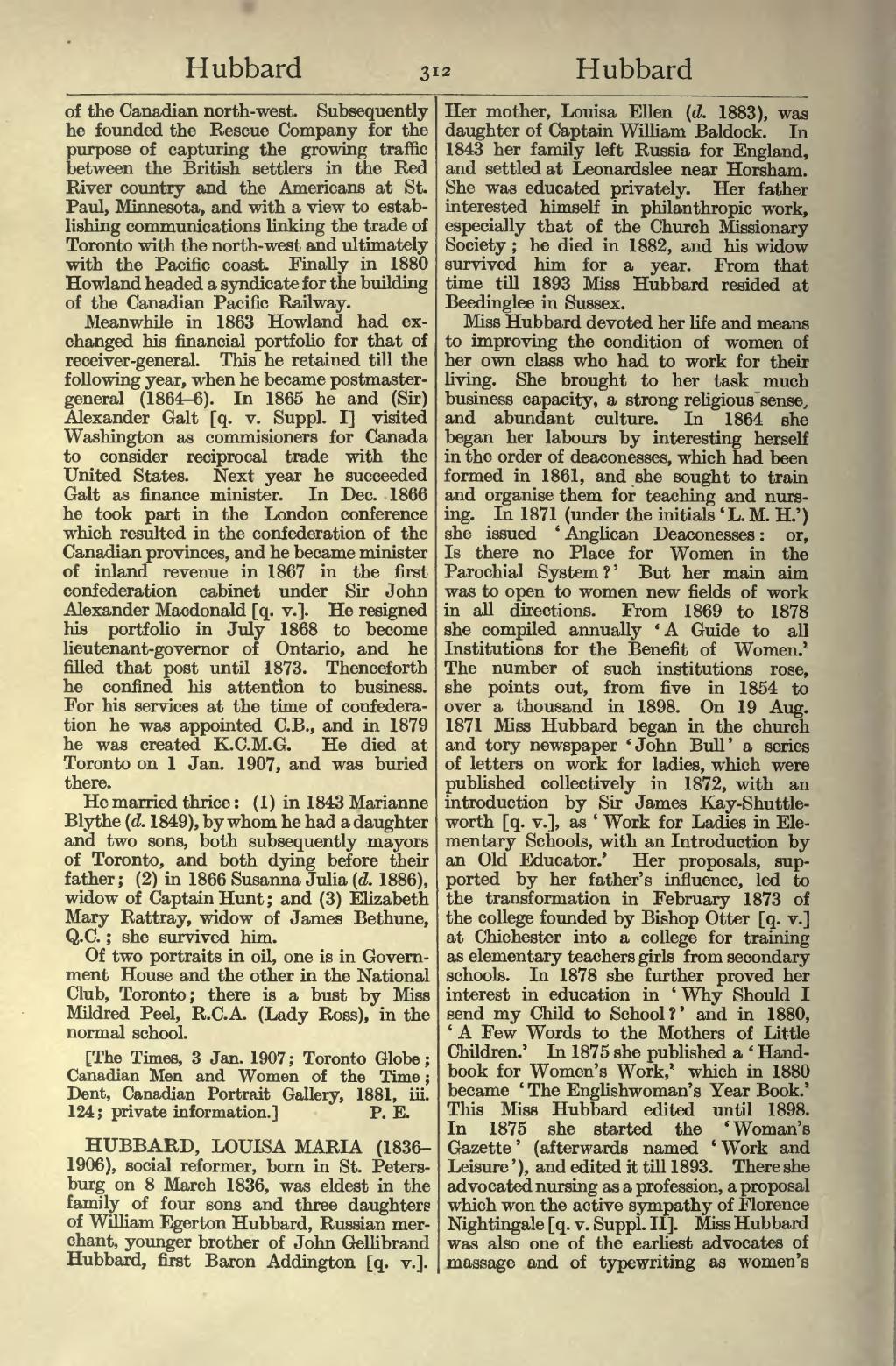of the Canadian north-west. Subsequently he founded the Rescue Company for the purpose of capturing the growing traffic between the British settlers in the Red River country and the Americans at St. Paul, Minnesota, and with a view to establishing communications linking the trade of Toronto with the north-west and ultimately with the Pacific coast. Finally in 1880 Howland headed a syndicate for the building of the Canadian Pacific Railway.
Meanwhile in 1863 Howland had exchanged his financial portfolio for that of receiver-general. This he retained till the following year, when he became postmaster-general (1864–6). In 1865 he and (Sir) Alexander Galt [q. v. Suppl. I] visited Washington as commisioners for Canada to consider reciprocal trade with the United States. Next year he succeeded Galt as finance minister. In Dec. 1866 he took part in the London conference which resulted in the confederation of the Canadian provinces, and he became minister of inland revenue in 1867 in the first confederation cabinet under Sir John Alexander Macdonald [q. v.]. He resigned his portfolio in July 1868 to become lieutenant-governor of Ontario, and he filled that post until 1873. Thenceforth he confined his attention to business. For his services at the time of confederation he was appointed C.B., and in 1879 he was created K.C.M.G. He died at Toronto on 1 Jan. 1907, and was buried there.
He married thrice: (1) in 1843 Marianne Blythe (d. 1849), by whom he had a daughter and two sons, both subsequently mayors of Toronto, and both dying before their father; (2) in 1866 Susanna Julia (d. 1886), widow of Captain Hunt; and (3) Elizabeth Mary Rattray, widow of James Bethune, Q.C.; she survived him.
Of two portraits in oil, one is in Government House and the other in the National Club, Toronto; there is a bust by Miss Mildred Peel, R.C.A. (Lady Ross), in the normal school.
[The Times, 3 Jan. 1907; Toronto Globe; Canadian Men and Women of the Time; Dent, Canadian Portrait Gallery, 1881, iii. 124; private information.]
HUBBARD, LOUISA MARIA (1836–1906), social reformer, born in St. Petersburg on 8 March 1836, was eldest in the family of four sons and three daughters of Wililam Egerton Hubbard, Russian merchant, younger brother of John Gellibrand Hubbard, first Baron Addington [q. v.]. Her mother, Louisa Ellen (d. 1883), was daughter of Captain William Baldock. In 1843 her family left Russia for England, and settled at Leonardslee near Horsham. She was educated privately. Her father interested himself in philanthropic work, especially that of the Church Missionary Society; he died in 1882, and his widow survived him for a year. From that time till 1893 Miss Hubbard resided at Beedinglee in Sussex.
Miss Hubbard devoted her life and means to improving the condition of women of her own class who had to work for their living. She brought to her task much business capacity, a strong religious sense, and abundant culture. In 1864 she began her labours by interesting herself in the order of deaconesses, which had been formed in 1861, and she sought to train and organise them for teaching and nursing. In 1871 (under the initials 'L. M. H.') she issued 'Anglican Deaconesses: or, Is there no Place for Women in the Parochial System?' But her main aim was to open to women new fields of work in all directions. From 1869 to 1878 she compiled annually 'A Guide to all Institutions for the Benefit of Women.' The number of such institutions rose, she points out, from five in 1854 to over a thousand in 1898. On 19 Aug. 1871 Miss Hubbard began in the church and tory newspaper 'John Bull' a series of letters on work for ladies, which were published collectively in 1872, with an introduction by Sir James Kay-Shuttleworth [q. v.], as 'Work for Ladies in Elementary Schools, with an Introduction by an Old Educator.' Her proposals, supported by her father's influence, led to the transformation in February 1873 of the college founded by Bishop Otter [q. v.] at Chichester into a college for training as elementary teachers girls from secondary schools. In 1878 she further proved her interest in education in 'Why Should I send my Child to School?' and in 1880, 'A Few Words to the Mothers of Little Children.' In 1875 she published a 'Handbook for Women's Work,' which in 1880 became 'The Englishwoman's Year Book.' This Miss Hubbard edited until 1898. In 1875 she started the 'Woman's Gazette' (afterwards named 'Work and Leisure'), and edited it till 1893. There she advocated nursing as a profession, a proposal which won the active sympathy of Florence Nightingale [q. v. Suppl. II]. Miss Hubbard was also one of the earliest advocates of massage and of typewriting as women's
